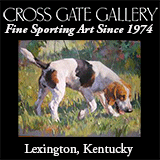 Mary Phillips Coker photo
Mary Phillips Coker photo
The Huntsmen’s Room of the Museum of Hounds and Hunting at Morven Park is a space that honors all North American huntsmen for their existential contributions to our sport. Enshrined therein are the images and histories of certain huntsmen who, by their demonstrated skill with hounds, their courage across country, and their unselfish and complete dedication to the sport, have been selected for individual honor in representing their peers.
In the same room stands a sculpture of the Old Virginian by the important American artist (and Hall of Fame polo player) Charles Cary Rumsey (1879–1922). This is one of Rumsey’s many smaller bronzes of horses, though he is probably best know for his grander works such as war memorials, the Three Graces Fountain at Forest Lawn Cemetery, his controversial nude, The Pagan, and the triumphal arch and colonnade at the Manhattan entrance to the Manhattan Bridge.
Mary Phillips Coker’s snapshot of Rumsey’s bronze in context with the image of recently deceased Albert Poe may not be an award-winning photograph—Mary has already won her share of awards and attention for her artistry and sculpture—but for those of us in the foxhunting fraternity, the photograph has a stirring significance. The mounted Old Virginian, walking with his hounds in this hall of memories where fitting tributes have been paid to both Albert and Melvin Poe, makes us wonder if we have seen the last of such Virginians with their passing—countrymen born in a simpler time when youngsters grew up absorbing naturally the secrets of the fields and woods and hunting for the dinner table and for sport. If so, aren’t we lucky to have been here in their time?
Posted June 10, 2019

















